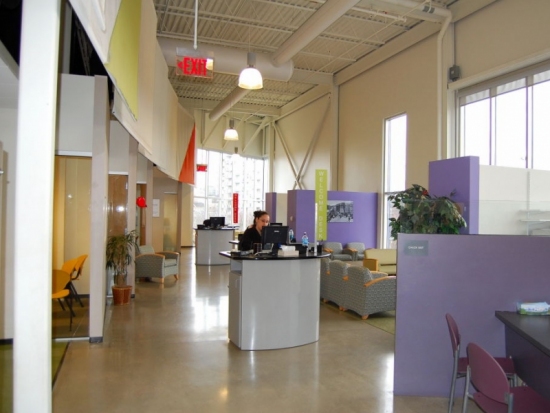Obtain certificate of occupancy; identify and resolve potential problems; make adjustments and modifications when needed.
Occupancy
Occupancy
Print/View All
What is Occupancy?
After construction is complete, departments and staff are moved into the new facility and/or renovated space for a fully operational facility. While it is encouraged to engage staff throughout the entire design process, it is crucial to provide an orientation to the new facility and/or renovated space, its design features, and equipment to improve the transition from old practices to new.
Occupancy Activities
Activities occurring during occupancy that are led by the healthcare organization include: obtaining feedback from neighborhood leaders, performing community outreach, and planning marketing activities. Activities occurring during occupancy that are led by the design team include licensing.
Evidence-Based Design
In an EBD process, data is often collected after occupancy to evaluate whether hypothesized outcomes have been achieved. After you occupy the building you will complete Step Eight: post-occupancy evaluation.
Design Activities
Print Design ActivitiesSee Evidence Based Design tab for EBD activities during this phase
Coordination of inspection and licensure reviews; If LEED status was pursued, finalize the LEED certification process - complete all documentation, checklist, LEED credit templates, project narrative; submit documentation to USGBC.
Performing community outreach; notify the local community about the opening of the new facility; obtain feedback from neighborhood leaders.
Prior to accepting patients, it is helpful to have the staff practice typical functions and scenarios so they are not performing basic tasks for the first time where patient care is involved.
Evidence-Based Design Activities
Print Evidence-Based Design ActivitiesFAQs
Print FAQsFeedback can be obtained from public meetings, interviews, focus groups, or surveys. Opinions should be evaluated by a team for the impact on both operations and the patient experience. There are often suggestions which have a minimal impact and little cost to implement, but other suggestions may be out of scope from a financial or strategic perspective. Expectations should be set relative to how suggestions will be evaluated, and in some instances it will be important to follow up directly with those making suggestions to ensure they know their opinions are heard and valued, even if not implemented.
A Temporary Certificate of Occupancy (TCO) is for a temporary period of time and is usually obtained when there is a certain portion of the building the is determined to be habitable while another section is still under construction, or where minor construction is still underway, but it is safe for non-construction personnel to occupy the area.
The procedure and requirements for the Certificate of Occupancy (CO) vary widely from jurisdiction to jurisdiction, but this information is often available online. There are typically timeframes associated with both the time from the request for an inspection, as well as the intended occupancy date. The inspection request is made by the Contractor, the Owner, or the Owner’s representative.
Resources
Print ResourcesMarketing dental services to low income/underserved populations may seem unnecessary, considering that most safety net clinic patients have no other places to obtain dental care and most clinics have long waiting lists for appointments. However, lenders don't necessarily know that. The safety net dental clinic equivalent of a for-profit business "promotion" is the clinic's "outreach" to attract patients. Generally, this amounts to just getting the word out when the clinic first opens. The outreach plan should demonstrate to lenders and others that the organization's services will be adequately utilized.
Phases and activities related to this resource include:
Occupancy
- Marketing/outreach planning
Created by the California HealthCare Foundation. Phases and activities related to this resource include:
Occupancy
- Liscencing
Created by the California HealthCare Foundation. Phases and activities related to this resource inlcude:
Organizational Readiness
- Development of project budget
- Explore various financing options
Occupancy
- Liscensing
Created by Clinica Sierra Vista. Phases and activites related to this resource include:
Construction
- Transition planning
- Project close out
Occupancy
- Marketing/Outreach planning
Study Guide 3: Integrating Evidence-Based Design: Practicing the Healthcare Design Process.
Guide Three pulls together the evidence-based design (EBD) process to walk you through the key steps of the design process in detail from pre-design, design, construction and occupancy. Practical examples demonstrate key areas and show how EBD is practically applied.
Phases and activities related to this resource include:
Organizational Readiness
Pre-Design
- Evaluate work flow
- Start conceptual diagramming
Design
- Continue conceptual diagramming
- Design development
- Bid and award-this may be phased based on contract type
Construction
- Substantial completion
- Final completion
Occupancy
Created by Labs for the 21st Century/EPA/DoE and covers the entire design process with a focus on sustainability. This resource specifically covers the Occupancy phase.
Created by New York State Division of Housing and Community Renewal (DHCR)/Franke Consulting Group.
Created by the Facility Guidelines Institute, 2010 edition. There is a read only version of the guidelines at the bottom of the linked page. Phases and Activities applicable to this resource include:
Pre-Design
- Select/survey sites and evaluate space availability
- Property aquisition/site control
- Start conceptual diagraming
Design
- Continue conceptual diagraming
- Schematic design
- Design development
- Permit process
- Zoning/use processing
- Construction documents
Construction
- Notice of completion
- Final completion
- Commissiong phase
Occupancy
- Certificate of occupancy
- Licensing
Clinicia Sierra Vista, basked in Bakersfield, California shared a pre-move checklist example with us to help other clinics think about the items that need to be addressed before occupying your new building.
Clinic Examples
Print Clinic ExamplesWith 16 health centers and 54 different locations, Clinica Sierra Vista provides health care services to a large, underserved Hispanic population spread over 6,000 square miles. According to Doug...
